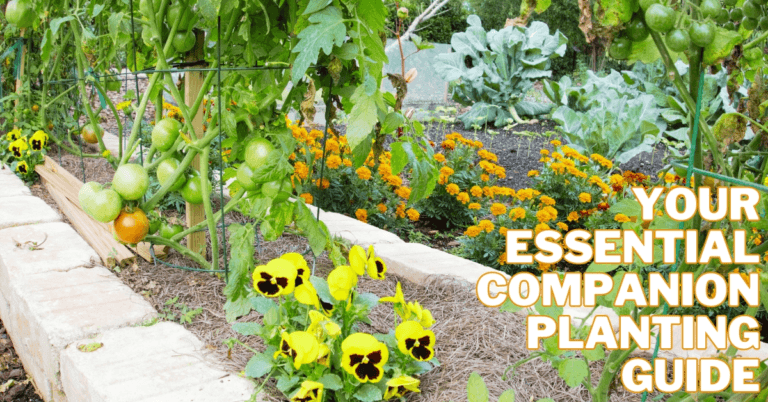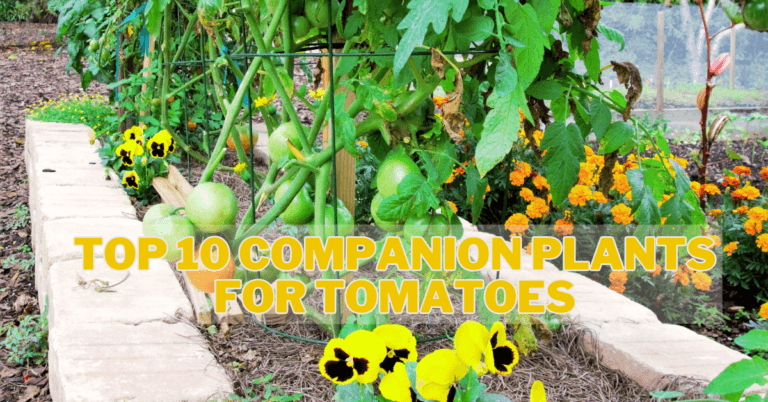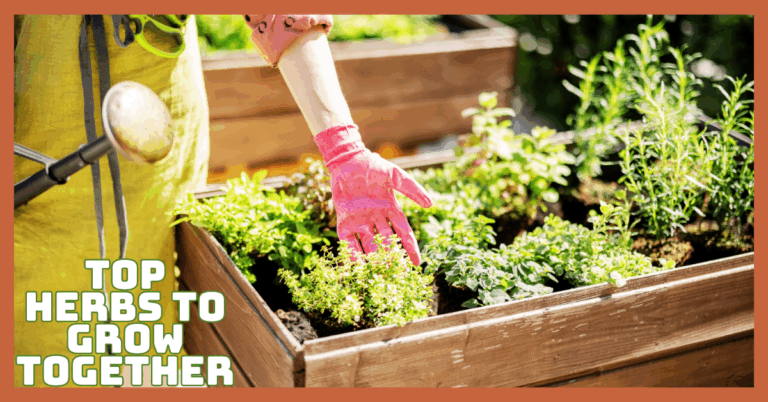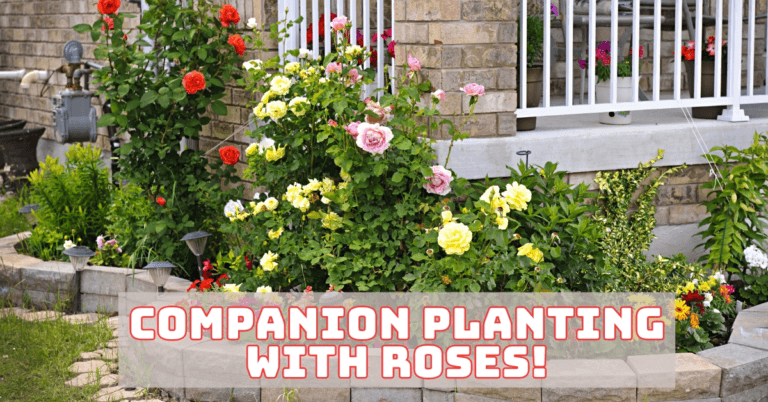Companion Flowers For Vegetables
The Ultimate Guide To Companion Flowers For Vegetables
Imagine a vegetable garden where every plant thrives and helps its neighbours flourish. Companion flowers for vegetables create this harmonious setup, attracting beneficial insects, deterring pests, and naturally boosting growth.
This guide will explore the best companion flowers to plant alongside popular vegetables.
From enhancing soil health to adding beauty and balance, these flowers offer more than just colour—they’re essential allies for a bountiful garden.
Dive in to learn how to cultivate a healthier, more resilient vegetable garden with companion flowers!

Why Companion Flowers Matter In The Vegetable Garden
Using flowers as companion plants in a vegetable garden serves several important purposes:
1. Attracting Pollinators
Bright, fragrant flowers attract bees, butterflies, and pollinators to your garden. These helpers are vital for vegetables like tomatoes, cucumbers, squash, and peppers.
They improve fruit sets and increase yields by transferring pollen between flowers, ensuring more robust growth and produce. Flowers like marigolds and sunflowers naturally attract these essential helpers.
2. Repelling Pests
Some flowers emit scents or release chemicals that deter unwanted pests, acting as natural repellents in the garden. For example, marigolds ward off nematodes, while nasturtiums repel aphids.
Interplanting these flowers creates a barrier against harmful insects, minimizing the need for chemical pesticides and promoting a healthier garden ecosystem.
3. Soil Health
Certain flowers contribute to soil health by enriching it with essential nutrients or attracting beneficial microbes. For instance, legumes like clover and sweet peas fix nitrogen, boosting soil fertility over time.
Other flowers encourage beneficial soil organisms, creating an environment supporting vegetable growth and maintaining long-term soil health.
4. Biodiversity
Adding flowers to your vegetable garden increases biodiversity, fostering a balanced ecosystem that supports beneficial insects, microbes, and other tiny organisms.
This diversity naturally enhances pest control, stabilizes the garden’s ecology, and improves resilience against diseases, creating a harmonious space where vegetables can thrive alongside supportive plant life.
5. Improving Growth Conditions
Companion flowers help create favourable vegetable microclimates by offering shade and protection from harsh weather.
Taller flowers can block strong sunlight or winds, safeguarding more delicate plants. This enhanced stability promotes healthier growth, leading to higher yields as the vegetables thrive in a more nurturing environment.
6. Enhancing Flavour
Certain flowers, particularly basil, enhance the flavour of nearby vegetables. When these companion plants are grown together, they create a synergistic effect that can elevate the taste and quality of your produce. This pairing enriches your culinary experience and adds beauty to your garden.
Companion Flowers For Vegetables
Here’s a look at some of the best flowers to plant alongside vegetables and their benefits.
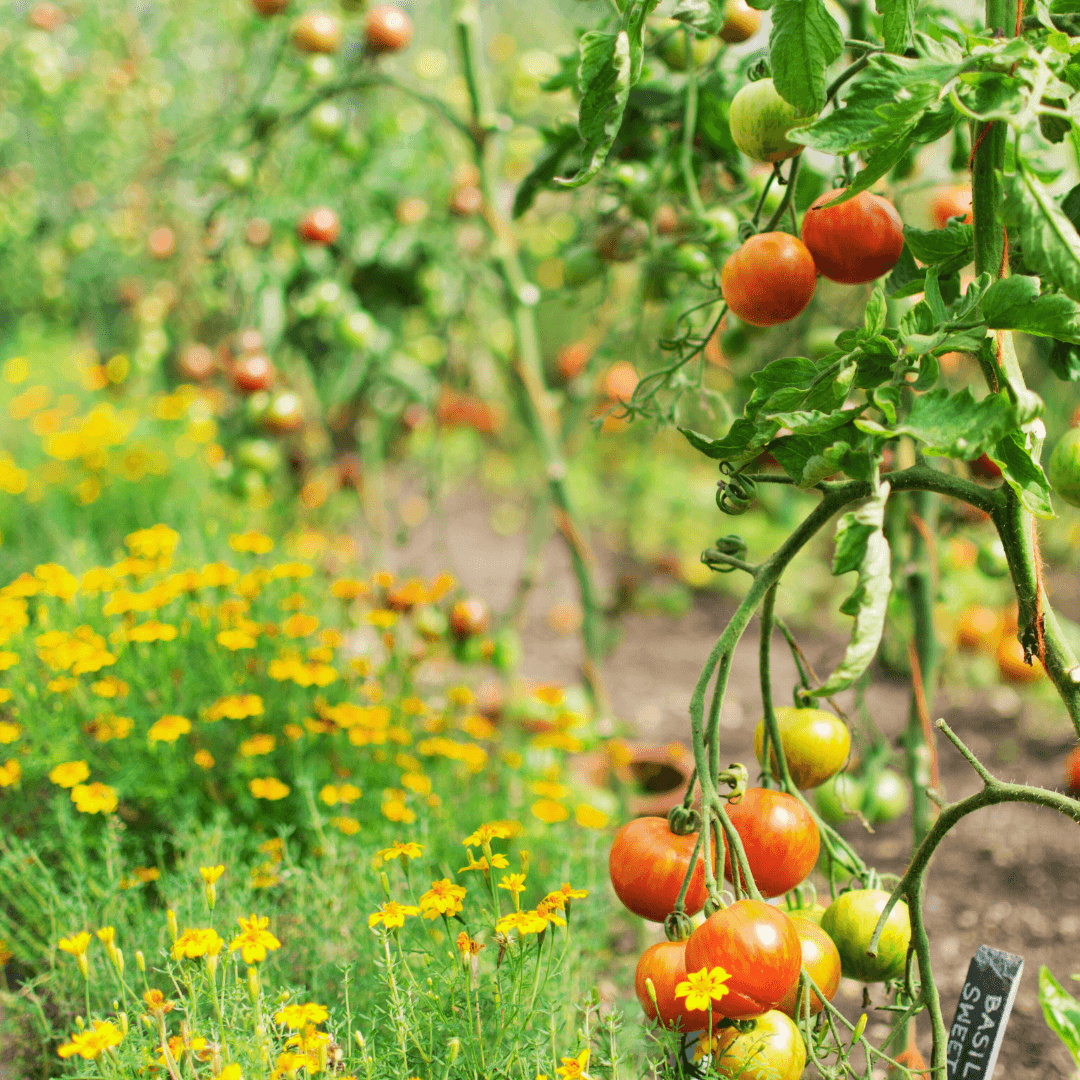
1. Marigolds (Tagetes spp.)
Benefits Of Marigolds (Tagetes spp.)
Marigolds are among the most popular companion flowers because they repel pests, including aphids, nematodes, and whiteflies. Their strong fragrance keeps harmful insects away from nearby vegetables.
Best Vegetables To Pair Marigolds (Tagetes spp.) With
Tomatoes, cucumbers, squash, carrots, and beans.
How To Plant Marigolds (Tagetes spp.)
Marigolds are excellent vegetable companion flowers. Sow seeds directly in sunny spots around your garden or between rows.
These hardy flowers increase, creating a protective barrier against pests. Simply scatter seeds and cover lightly with soil and water. Marigolds thrive with minimal care and enrich garden biodiversity.
2. Nasturtiums (Tropaeolum majus)
Benefits Of Nasturtiums (Tropaeolum majus)
Nasturtiums are known as “trap crops” because they attract aphids, beetles, and caterpillars, drawing them away from vegetables. They also deter squash bugs and cucumber beetles.
Best Vegetables To Pair Nasturtiums (Tropaeolum majus) With
Tomatoes, radishes, beans, cucumbers, and squash.
How To Plant Nasturtiums (Tropaeolum majus)
To plant nasturtiums, a popular choice among companion flowers for vegetables, sow seeds along the edges of garden beds or in containers near crops that need protection.
These resilient flowers thrive in poor soil, so minimal fertilization is required. They naturally deter pests, adding both beauty and function to your garden.
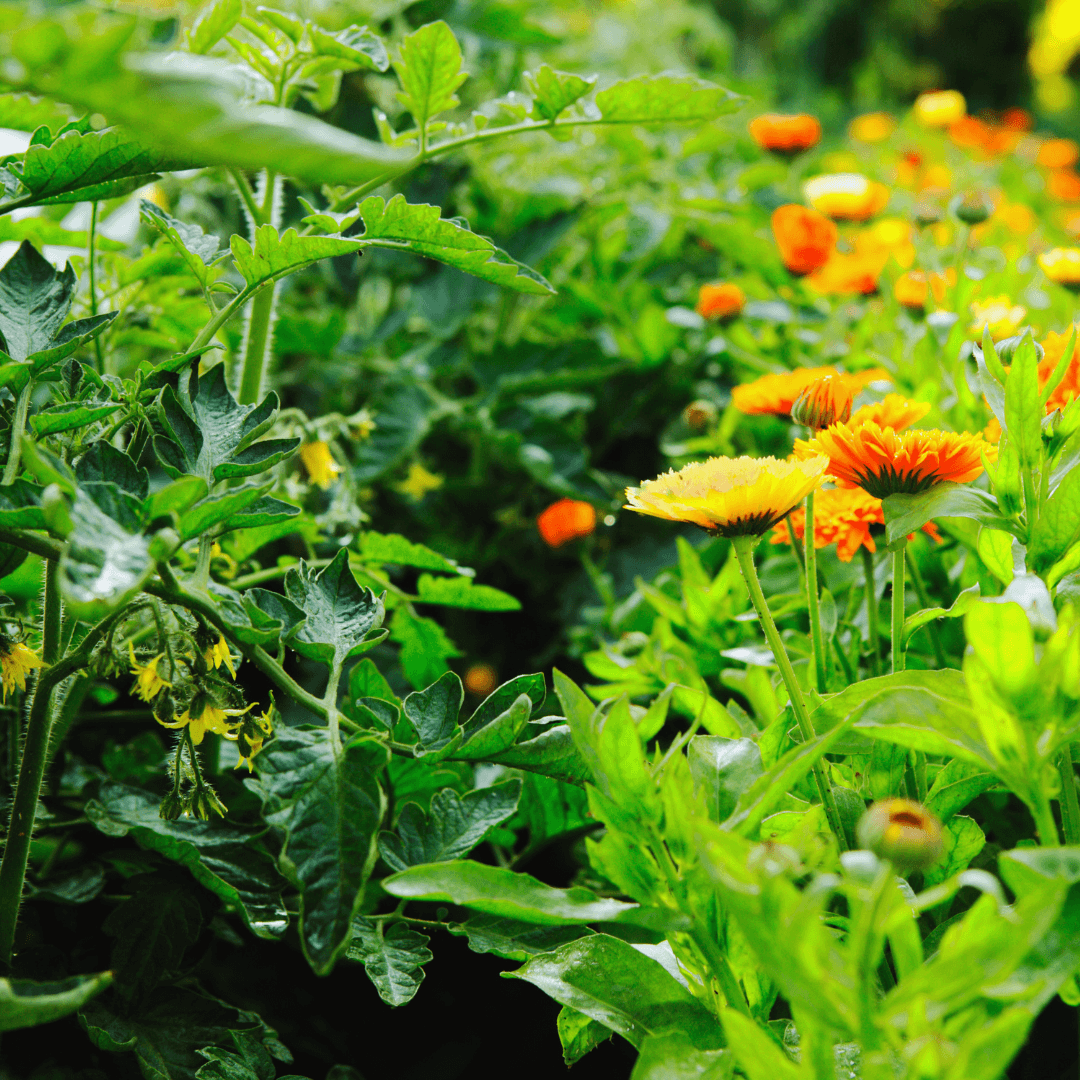
3. Calendula (Calendula officinalis)
Benefits Of Calendula (Calendula officinalis)
Also known as ‘pot marigold,' calendula attracts pollinators and beneficial insects like hoverflies, which prey on aphids. Its flowers have edible petals and also offer medicinal uses.
Best Vegetables To Pair Calendula (Calendula officinalis) With
Peppers, tomatoes, carrots, and lettuce.
How To Plant Calendula (Calendula officinalis)
Plant seeds in sunny spots with well-draining soil to grow calendula. Regularly remove spent blooms (deadhead) to promote continuous flowering throughout the season. Calendula is easy to maintain and adds vibrant colour, attracting beneficial insects to your garden.
4. Borage (Borago officinalis)
Benefits Of Borage (Borago officinalis)
Borage attracts bees, one of the most important pollinators for vegetable gardens. It is especially beneficial for tomatoes, squash, and strawberries. Borage also improves soil quality by adding trace minerals.
Best Vegetables To Pair Borage (Borago officinalis) With
Tomatoes, strawberries, and squash.
How To Plant Borage (Borago officinalis)
Plant borage in a spot with full sun to partial shade. This self-seeding annual attracts bees and other pollinators and is perfect for areas needing additional pollination. Borage requires little maintenance and re-seeds itself yearly for consistent garden support.
5. Sunflowers (Helianthus annuus)
Benefits Of Sunflowers (Helianthus annuus)
Sunflowers attract pollinators and act as a ‘trap crop' for aphids. Their tall stalks can also shade leafy greens in hot weather and support climbing plants like beans.
Best Vegetables To Pair Sunflowers (Helianthus annuus) With
Corn, beans, cucumbers, and leafy greens.
How To Plant Sunflowers (Helianthus annuus)
To plant sunflowers, select garden edges to prevent them from shading smaller plants. They thrive in full sun and well-drained soil.
Sow seeds directly into the soil, spacing them to accommodate their height, and water regularly to support healthy growth.

6. Zinnias (Zinnia spp.)
Benefits Of Zinnias (Zinnia spp.)
Pollinators and pest-eating predatory insects like lacewings and ladybugs are drawn to zinnias. Their vivid blossoms give the garden a pop of colour.
Best Vegetables To Pair Zinnias (Zinnia spp.) With
Tomatoes, peppers, and cucumbers.
How to Plant Zinnias (Zinnia spp.)
Plant zinnias in sunny areas around garden beds or among vegetable rows. Zinnias are vibrant companion flowers for vegetables. They are low-maintenance and add colour while attracting pollinators to support vegetable growth.
7. Cosmos (Cosmos bipinnatus)
Benefits Of Cosmos (Cosmos bipinnatus)
Cosmos attract bees, butterflies, and predatory insects like hoverflies, which help control aphid populations. They are drought-tolerant and add a lovely, airy texture to the garden.
Best Vegetables To Pair Cosmos (Cosmos bipinnatus) With
Tomatoes, corn, and beans.
How To Plant Cosmos (Cosmos bipinnatus)
When planting cosmos, pick a spot that receives whole light and has well-drained soil. These vibrant flowers thrive as border plants or can be interplanted with taller vegetables for added visual interest. Cosmos require minimal care, attracting pollinators and enhancing the overall beauty of your garden.
8. Lavender (Lavandula spp.)
Benefits Of Lavender (Lavandula spp.)
Lavender’s strong aroma deters moths, fleas, and whiteflies, helping to protect nearby vegetables. It also attracts pollinators and improves the garden's aesthetic appeal.
Best Vegetables To Pair Lavender (Lavandula spp.) With
Carrots, cabbage, and cauliflower.
How to Plant Lavender (Lavandula spp.)
To plant lavender, select sunny spots with well-drained soil, either along garden borders or in pots near vegetable beds.
Once established, this aromatic herb requires minimal watering and naturally repels pests, making it a beautiful, low-maintenance addition to your vegetable garden.

9. Chamomile (Matricaria chamomilla)
Benefits Chamomile (Matricaria chamomilla)
Chamomile attracts beneficial insects like hoverflies and wasps. Its flowers can also improve the flavour of vegetables like cabbage and onions and reduce fungal infections.
Best Vegetables to Pair Chamomile (Matricaria chamomilla) With
Cabbage, onions, and beans.
How To Plant Chamomile (Matricaria chamomilla)
Chamomile is a versatile companion vegetable flower. To plant it, select a partially shaded area for more excellent growing conditions, allowing it to thrive alongside your crops. It proliferates among vegetables or in containers, thriving with minimal care.
Chamomile's gentle presence supports garden health and can attract beneficial insects, making it a versatile companion plant.
10. Sweet Alyssum (Lobularia maritima)
Benefits Of Sweet Alyssum (Lobularia maritima)
Sweet alyssum attracts beneficial insects, including parasitic wasps that prey on aphids and caterpillars. Its ground-covering nature helps to suppress weeds.
Best Vegetables To Pair Sweet Alyssum (Lobularia maritima) With
Lettuce, kale, carrots, and beans.
How To Plant Sweet Alyssum (Lobularia maritima)
Sow seeds between vegetable rows or garden bed edges to plant sweet alyssum. This resilient flower is an excellent option for filling gaps because it grows well in full sun to moderate shade. Sweet alyssum attracts pollinators and provides ground cover, enhancing garden beauty and health.
11. Yarrow (Achillea millefolium)
Benefits Of Yarrow (Achillea millefolium)
Yarrow is one of the top vegetable companion flowers, as it attracts beneficial insects like ladybugs and lacewings, improves soil quality, and boosts essential oil production in nearby herbs. The soil quality is enhanced, and neighbouring fragrant plants, such as herbs, produce more essential oils.
Best Vegetables To Pair Yarrow (Achillea millefolium) With
Tomatoes, basil, and lettuce.
How To Plant Yarrow (Achillea millefolium)
Plant yarrows in sunny spots around your garden. This hardy perennial adapts to various soil types and requires minimal care.
If it spreads, trim it back to maintain its shape. Yarrow attracts beneficial insects, supporting a healthy garden ecosystem.
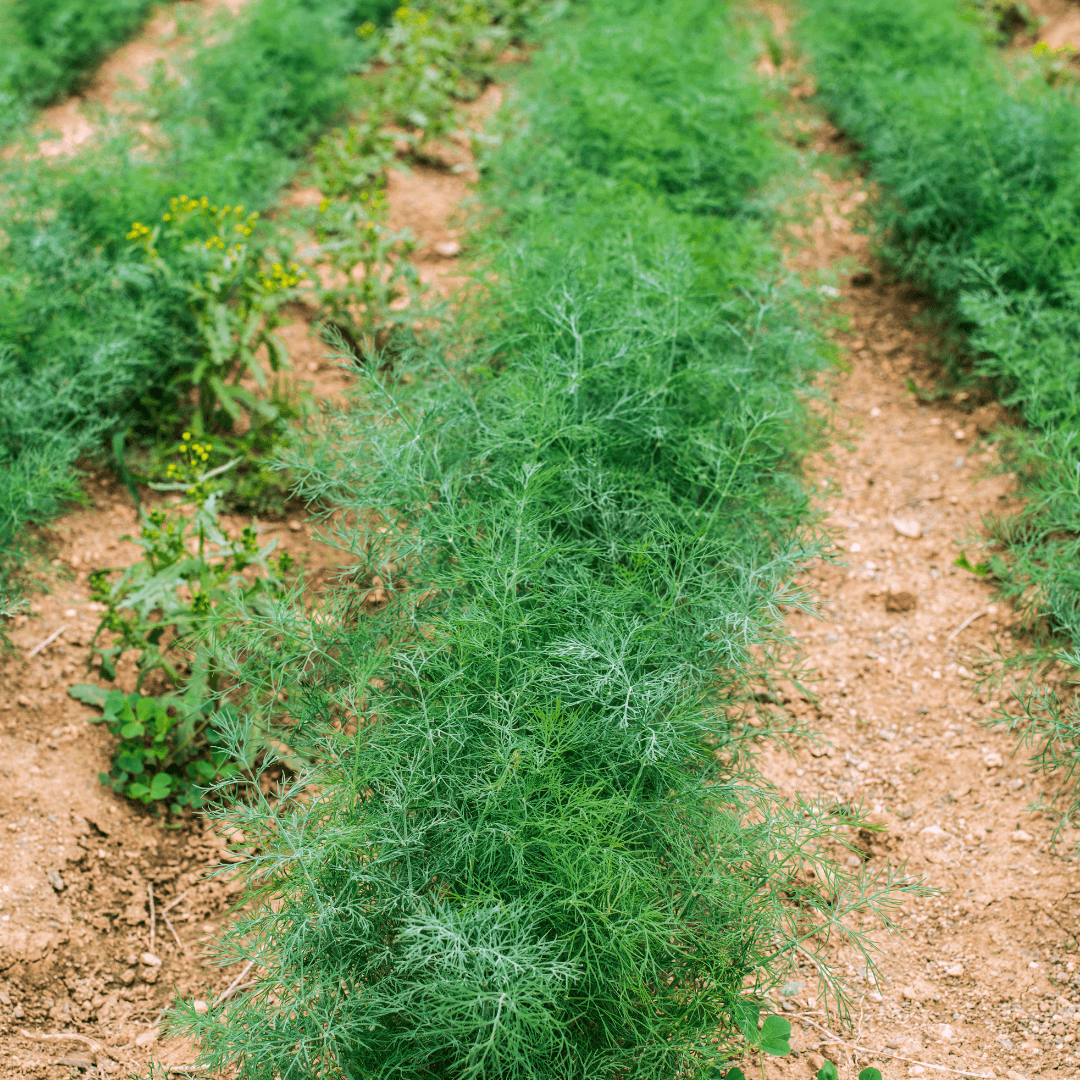
12. Dill (Anethum graveolens)
Benefits Of Dill (Anethum graveolens)
While technically an herb, dill is a fantastic flower-bearing plant that attracts predatory insects such as wasps and hoverflies, which help keep pests under control. Dill also enhances the flavour of vegetables like cabbage.
Best Vegetables To Pair Dill (Anethum graveolens) With
Cabbage, onions, lettuce, and cucumbers.
How To Plant Dill (Anethum graveolens)
To plant dill, place it near vegetables vulnerable to aphids or cabbage worms, as it naturally deters these pests. Dill thrives in full sun and can grow up to 3 feet tall, so position it thoughtfully to avoid shading smaller plants. Its feathery foliage also attracts beneficial insects.
13. Bee Balm (Monarda spp.)
Benefits Of Bee Balm (Monarda spp.)
Bee balm attracts pollinators, including bees and butterflies, which helps increase fruit set and yield in your vegetables. Its unique blooms add a striking touch to the garden.
Best Vegetables To Pair Bee Balm (Monarda spp.) With
Tomatoes, squash, peppers, and eggplants.
How To Plant Bee Balm (Monarda spp.)
Choose a location for bee balm planting that receives full sun-to-light shade and well-drained soil. This vibrant perennial spreads quickly, so allow ample space or plant it in a contained area. Bee balm attracts pollinators, making it an excellent addition to support garden biodiversity and crop health.
14. Petunias (Petunia spp.)
Benefits Of Petunias (Petunia spp.)
Petunias are excellent companion flowers for vegetables, as they deter pests like aphids, tomato worms, and leafhoppers while adding vibrant colour to the garden. They’re also a colourful addition to the garden, making them functional and beautiful.
Best Vegetables To Pair Petunias (Petunia spp.) With
Beans, tomatoes, peppers, and basil.
How To Plant Petunias (Petunia spp.)
To plant petunias, select a sunny spot and water them regularly. These versatile flowers thrive when interspersed among vegetable rows or used as border plants. They add colour while helping deter pests and attracting pollinators to support your vegetable garden.
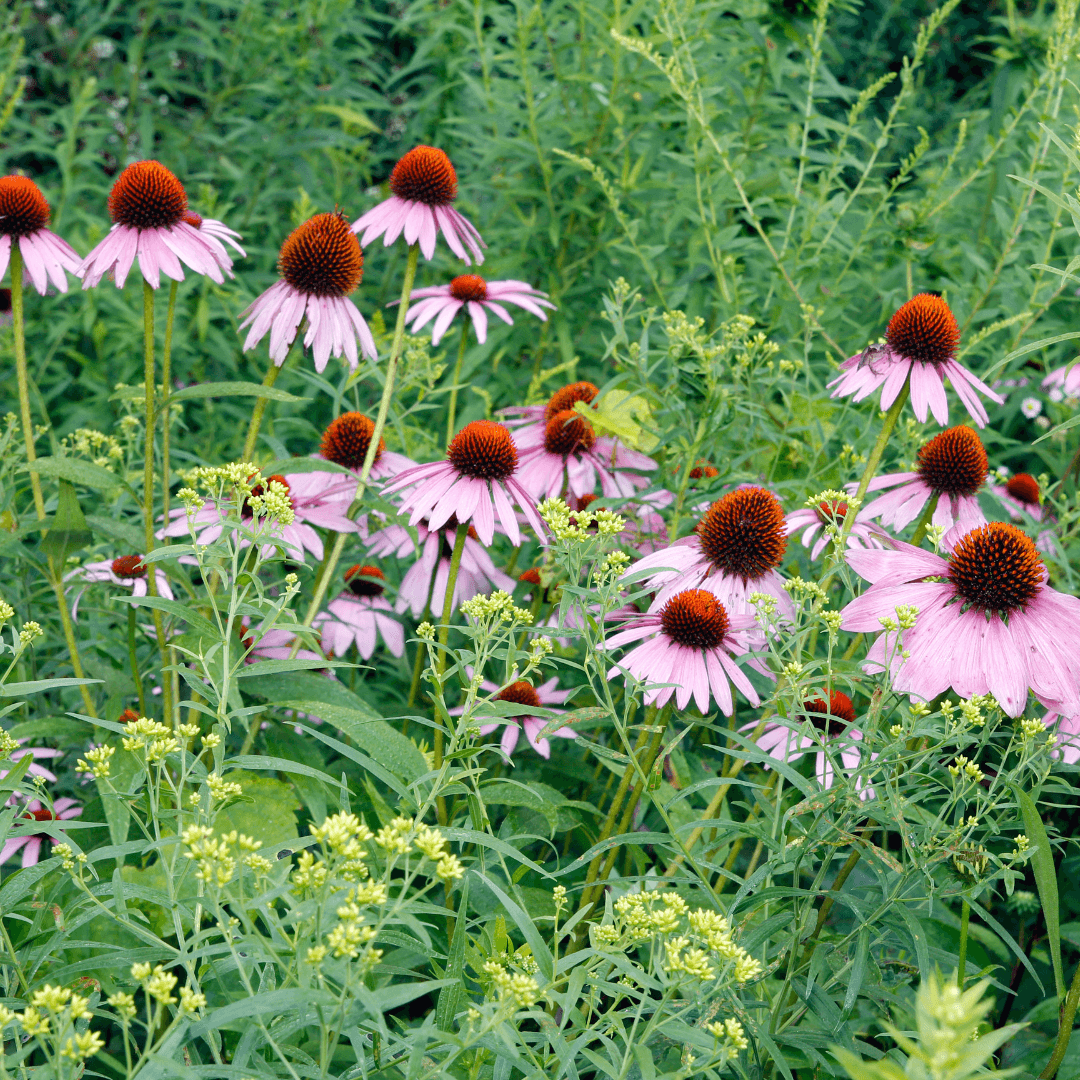
15. Coneflowers (Echinacea spp.)
Benefits Of Coneflowers (Echinacea spp.)
Coneflowers attract pollinators, including bees and butterflies, and help boost the garden's overall health by drawing in beneficial insects. They’re also drought-tolerant and very low-maintenance.
Best Vegetables To Pair Coneflowers (Echinacea spp.) With
Cucumbers, peppers, and tomatoes.
How To Plant Coneflowers (Echinacea spp.)
Plant coneflowers in sunny areas with well-drained soil. Position them along garden edges, where their height and vibrant blooms add structure and colour.
A lovely and useful addition to your food garden, these hardy perennials need little maintenance and draw pollinators.
16. Bachelor's Buttons (Centaurea cyanus)
Benefits Of Bachelor's Buttons (Centaurea cyanus)
Bachelor's buttons attract ladybugs and lacewings, naturally occurring predators of aphids and other common garden pests. Their long bloom time provides continual insect support.
Best Vegetables To Pair Bachelor's Buttons (Centaurea cyanus) With
Tomatoes, corn, and lettuce.
How To Plant Bachelor's Buttons (Centaurea cyanus)
Select locations with full sun and moderately fertile soil for these flowers. They thrive when planted along garden edges or interspersed with vegetables, where they can add colour, attract beneficial insects, and support vegetable growth. Their easy-care nature makes them an excellent companion choice.
17. Snapdragons (Antirrhinum majus)
Benefits Of Snapdragons (Antirrhinum majus)
Snapdragons attract pollinators and some beneficial predatory insects that help manage pests. They can also add a striking visual element to your vegetable garden.
Best Vegetables To Pair Snapdragons (Antirrhinum majus) With
Leafy greens, beans, and peas.
How To Plant Snapdragons (Antirrhinum majus)
Plant snapdragons during the excellent weather season and in a location with partial shade. These flowers do well along garden borders or between vegetable rows, where they add vibrant colour and help naturally deter pests. Snapdragons are low-maintenance and attractive companions for vegetables.
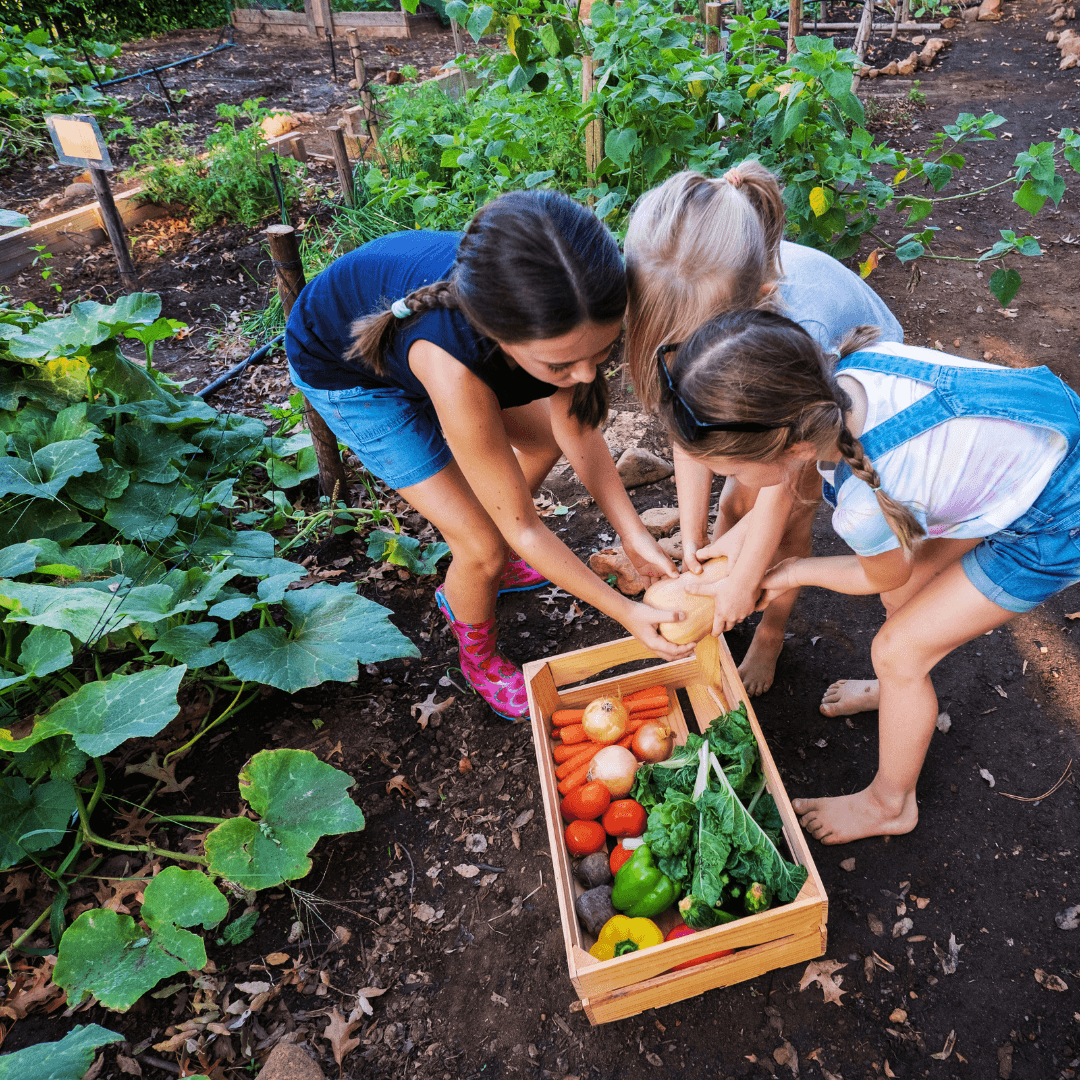
Planning Your Companion Flower Garden Layout
To optimize the benefits of companion flowers in your vegetable garden, take into account the following factors:
1. Spacing And Placement
When planting flowers, consider their height and shading effects. Taller flowers like sunflowers can shelter sun-sensitive crops, enhancing growth.
Smaller flowers like marigolds can be interplanted between vegetable rows, maximizing space and creating a vibrant, beneficial environment in your garden.
2. Colour And Bloom Time
Incorporating various flower colours and bloom times throughout the growing season is crucial for attracting pollinators.
This strategy ensures that flowers bloom at different intervals, providing a consistent food source for bees and butterflies, ultimately enhancing pollination and vegetable yields.
3. Rotation And Succession Planting
Rotation and succession planting of companion flowers for vegetables, like marigolds, helps control soil diseases and pests by disrupting pest life cycles and enhancing soil health each season.
Changing their placement disrupts pest life cycles and improves soil health. This practice maintains a thriving garden ecosystem and optimizes these flowers’ benefits throughout the growing seasons.
4. Layering Techniques
Creating a multi-layered garden involves utilizing vertical space by planting climbing flowers on trellises or supports next to taller vegetables. This strategy maximizes sunlight exposure for all plants and enhances visual interest. It allows for efficient use of space, promotes healthy growth, and increases overall yield.
5. Accessibility For Pollinators
Incorporating pollinator-friendly areas with companion flowers for vegetables, like patches of wildflowers near beds, attracts bees and butterflies to boost pollination and improve crop yields.
These areas should be strategically placed near vegetable beds, making them easily accessible. This accessibility encourages pollinator visits, boosting pollination rates and ultimately enhancing the yield and health of your vegetable crops.
6. Aesthetic Appeal
Enhancing garden beauty involves thoughtfully selecting flowers based on their shapes, colours, and heights. A diverse layout creates a visually captivating space that complements your vegetables.
This not only makes your garden more inviting but also encourages you to spend more time enjoying the natural beauty of your surroundings.
7. Maintenance Requirements
Matching maintenance needs means choosing flowers that share similar water and care requirements with your vegetables.
This alignment simplifies the upkeep process, reducing the time and effort needed for watering and care. When plants thrive together, they create a healthier garden ecosystem, ensuring all species flourish harmoniously.
FAQ
1. How Close Should I Plant Companion Flowers To My Vegetables?
Answer: The proximity depends on the type of flower and vegetable. Still, a general rule is to plant companion flowers within a couple of feet of the vegetables to ensure they provide their benefits. A slightly farther distance can still be effective for flowers that attract pollinators.
2. Do Companion Flowers Need Special Care Compared To Vegetables?
Answer: Most companion flowers are low-maintenance, but their care may vary depending on the type. For instance, flowers like marigolds and zinnias are hardy and require minimal care, while others like calendula benefit from regular deadheading to encourage new blooms.
3. Are There Any Vegetables That Don’t Benefit From Companion Flowers?
Answer: Most vegetables can benefit from companion flowers in some way, but the benefits vary. Root crops like carrots and beets may not attract many pests, so they might not need pest-repelling flowers nearby, although pollinator-attracting flowers can still help.
4. Will Planting Flowers With Vegetables Affect The Vegetable Flavour?
Answer: Certain companion flowers, like basil and dill, can enhance the flavour of neighbouring vegetables such as tomatoes and cabbage.
While most flowers won’t directly impact vegetable flavour, they can improve plant health, producing better-tasting produce.
5. Can I Grow Companion Flowers In All Climates?
Answer: Many companion flowers are adaptable to various climates, but it’s wise to choose varieties that suit your specific region.
For example, heat-tolerant flowers like sunflowers are great for warm climates, while calendula and pansies can handle cooler temperatures.
Conclusion
Adding companion flowers for vegetables to your food garden is an easy yet powerful approach to improving plant productivity and health.
These vibrant allies attract beneficial pollinators, deter pests, and enhance soil quality, creating a balanced ecosystem that supports your crops.
Embrace the power of companion planting, and watch your vegetable yields flourish while enjoying the added charm and colour that flowers bring to your gardening space.
I trust you enjoyed this article on The Ultimate Guide To Companion Flowers For Vegetables. Stay tuned for more blog posts soon. Take care!
JeannetteZ
>>>Please click here to read my all-inclusive article, About The Essential Companion Planting Guide<<<
>>>Please click here to read my all-inclusive article about Container Gardening<<<
>>>Are you interested in homegrown herbs and medicine? Please click here to find out more about it!<<<
Your Opinion Is Important To Me
Do you have thoughts, ideas, or questions? I would love to hear from you. Please leave me your questions, experiences, and remarks about this article, The Ultimate Guide To Companion Flowers For Vegetables, in the comments section below. You can also email me at Jeannette@Close-To-Nature.org.
Disclosure
This post may contain affiliate links. As an Amazon Associate and other affiliate programs, I earn from qualifying purchases at no extra cost to you. Please read my full affiliate disclosure.
You might also enjoy these blog posts:
Top 10 Companion Plants For Tomatoes
The Best Plants For Hydroponics And How To Grow Them
10 Winning Herb And Vegetable Companion Planting Combinations
Exploring Animal Communication: What Your Pet Is Trying To Tell You



